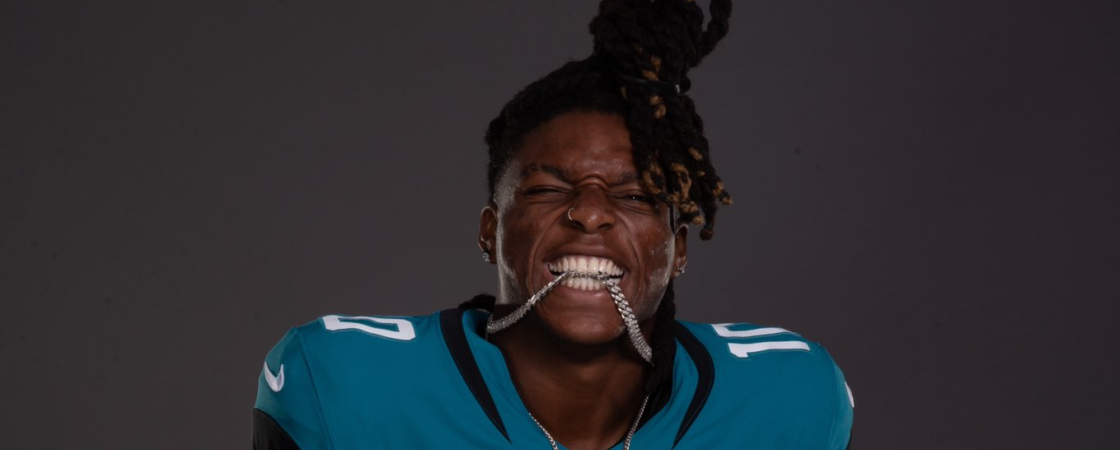There’s an idea in a lot of fantasy football circles that weapon versatility is paramount. After all, rushing running backs with some receiving chops? That’s the sweet spot, especially with the prevalence of half-PPR and PPR leagues these days. After all, a catch is a free point! That’s like ten rushing yards! Some of us, myself included (up until about 48 hours ago), think that it works the other way around, as well. Deebo Samuel, Robert Woods, Laviska Shenault, these are all guys who add rushing upside! So like moths to a flame in the shape of a Nyheim Hines, we rush toward (pun intended) these rushing wide receivers to give our fantasy football squads a little extra boost.
What Do We Expect?
But with these rushing wide receivers… what exactly do we expect? Is it an extra point here or there (couldn’t that get accomplished with a guy who gets an extra target or two, in PPR)? Quiet, reasonable voice. Are we flocking toward them in error? I put a little poll up on Twitter this week to ask what exactly people expect from these receivers, per week:
Before I start to break this down, I want to explain a little bit of the dataset I’m working with: the top 50 wide receiver scorers in each of the last three seasons, so a 150-player sample size. Of these 150 wide receiver seasons, 106 registered a rush attempt. Maybe there are wide receivers who are better at rushing the football, but they weren’t even in the top-fifty, so who cares? Of the 106 wide receivers in the dataset who notched carries, 84 WRs (79%) failed to reach even 0.1 fantasy points per game through rushing. So, let’s strip those bad boys away. That leaves us with 21 seasons to work with, or about 7 wide receivers a year.
Let’s start with the reasonable people: the 37.8% of respondents who answered 0.1 fantasy points to 0.5 fantasy points per week, rushing. Due to a typo in my poll, I will call this group “under 0.6 fantasy points per week.” Spoiler alert, but this group was correct. Of the 21 wide receivers to finish within the top-50 in the last three seasons with at least 0.1 fantasy points through rushing per game, exactly two-thirds of rushing wide receivers finished with less than 0.6 fantasy points per game on the ground. 66.7%! Congratulations to those who answered that. Let’s get into the rest of the receivers, and then figure out what exactly led us to believe what we believe about rushing wide receivers (hint: it’s getting excited!).
Let’s Disappoint Some People
29.7% of respondents to the poll expected 0.6 to 0.99 fantasy points out of their rushing wide receiver. I call this group “I want to say a point per game but I am too cautious.” All told over the last three years, three wide receivers have between 0.6 and 0.99 fantasy points per game through rushing (2020 Robert Woods, Tyreek Hill and Chase Claypool). Three of 21, if you remember your fractions, is one-seventh of the wide receivers (14.2%).
Four wide receivers (19%) finished with between 1.0 fantasy points and 1.5 fantasy points. But, if we’re being more honest with ourselves, 4-of-21 wide receivers finished with between 1.05 and 1.3 fantasy points per game through rushing… and two of them were Curtis Samuel. Unfortunately, that total makes only 21.6% of respondents happy.
Now, let’s get to the dreamers. 10%. Ten percent! One in ten responded 1.5+ fantasy points per game. Unfortunately for these drafters, no wide receiver has come close to matching this number in the last three years. Deebo Samuel’s 1.29 fantasy points per game on the ground in 2019 ranks as the top rushing wide receiver fantasy point scoring in the last three years.
So What Does This Mean?
Remember that dataset of 21 WRs who finished inside the top-50 while averaging at least 0.1 fantasy points rushing per game? That was fifteen guys:
A.J. Brown, Brandin Cooks, Brandin Aiyuk, CeeDee Lamb, Chase Claypool, Curtis & Deebo Samuel, DeSean Jackson, Emmanuel Sanders, Jarvis Landry, Laviska Shenault, Mike Williams, Robert Woods, Sterling Shepard, and Tyreek Hill.
Let’s take a look at the ideas people expressed to me as to why they get so excited about rushing wide receivers. What leads to people having an astonishly overinflated sense of wide receivers can do on the ground? Well, I think it breaks down into exuberance and excitability.
Exuberance
People think that rushing WRs are just so good that getting them the ball means that great things are happening. Unfortunately, that doesn’t flesh with reality. While the average RB carry in 2020 went for about 4.3 yards, a carry from the WR above averaged about 7.13 yards. So, that extra few yards is useful when trying to gain ten, but not the sort of thing we really get up and shout about in fantasy football. After all, in a PPR league, one catch for zero yards outgains that scoring.
Think about getting a bowl of whipped cream and one cherry. “What the hell is this?” you might think to yourself, “who would get excited about this? Where’s the rest?” A lot of players think of WR rushes as a little bit on top of the sundae of fantasy football production, when in reality, they’re part of the whole package. When you look at them directly, it’s hard to get excited. Just like looking straight at some whip and cherry at your favorite sundae place. But, we look at fantasy rush attempts like they’re extra. They’re not extra. The NFL play binary dictates that a rush is a pass not attempted, and vice versa. Obviously, gaining first downs changes that, but you get my point. It’s not extra, it’s in lieu of.
But, it seems extra. It’s in a separate category, exciting us. “Look at the rushing, too!” you say to 15 yards to go with Robert Woods’ 5 catch, 60-yard effort. But, would you be as excited if it was 6 catches for 65 yards? Because in full-PPR, those score the same. But, the 15 rush yards look like a little extra cherry on top of the production sundae. They have a psychological impact of “free points.”
Excitability
Excitability sort of goes hand-in-hand with exuberance. One thing I kept getting in discussions of my polls was the excitement factor: a wide receiver rush could go to the house on any given play, or they usually rip off big gains. But do they?
It’s just that we generally see these guys crack big plays rushing, and don’t really think about the plays where they fall flat on their faces. But, let’s take a look at the big plays. And I am going to qualify a “big play” as a rush for 20 yards or more. After all, in a full PPR league that is the equivalent of one catch for ten yards, and a 10 yard per reception threshold is not a difficult bar to cross for fantasy-relevant wide receivers. Let’s call this the breakeven point where the rush was a good thing for your fantasy options compared to a pass. After all, a 20-yard rush and a 10-yard reception are both worth 2 points in PPR.
Those 15 wide receivers I listed off above? The ones with the fantasy-relevant contributions? They combined for 8 runs of at least 20 yards in 2020. They combined for six 30+ yard runs, and Curtis Samuel and Robert Woods each chipped in a run of over 40 yards each.
The big plays just aren’t there, but we really feel like they should be! After all, we see the guy running down one-fifth of the field. But, until he reaches 20 yards, it would have been better suited for PPR fantasy football scoring. But it was more fun to watch, and a less routine play, so it’s more likely to stick in your head.
The Takeaway
By and large, people think that drafting a wide receiver who can rush just adds a tiny bit to their production. But, the reality is that most of the time, the receiver would have just been better off catching the ball, especially in leagues that reward the act of a catch with a full point. Think of it that way: if the rush went for fewer than 10 yards, it would have been better off as a pass.
And, ultimately, most of the time, the rushes don’t do much. As I said, the top-fifteen guys who could help you out in this regard combined for just 8 plays that wouldn’t have been better off as a reception for 10 yards.
So, go ahead and get these receivers, knowing that their rushing is a fun little cherry. Use it sparingly, use it as a tiebreaker. But don’t tout a guy who can’t track a ball downfield (Laviska Shenault) because he can run a little bit. Gauge him on his WR prowess, then use his rushing as a tiebreaker; use it as a way to move him within tiers. Don’t use it, for example, as a reason to put Marvin Jones behind Laviska Shenault.
That’s just overthinking wide receivers.



